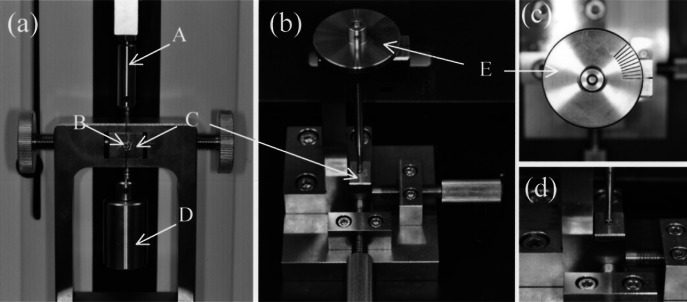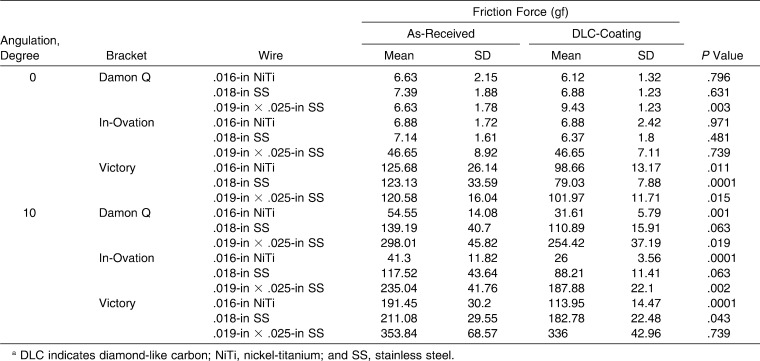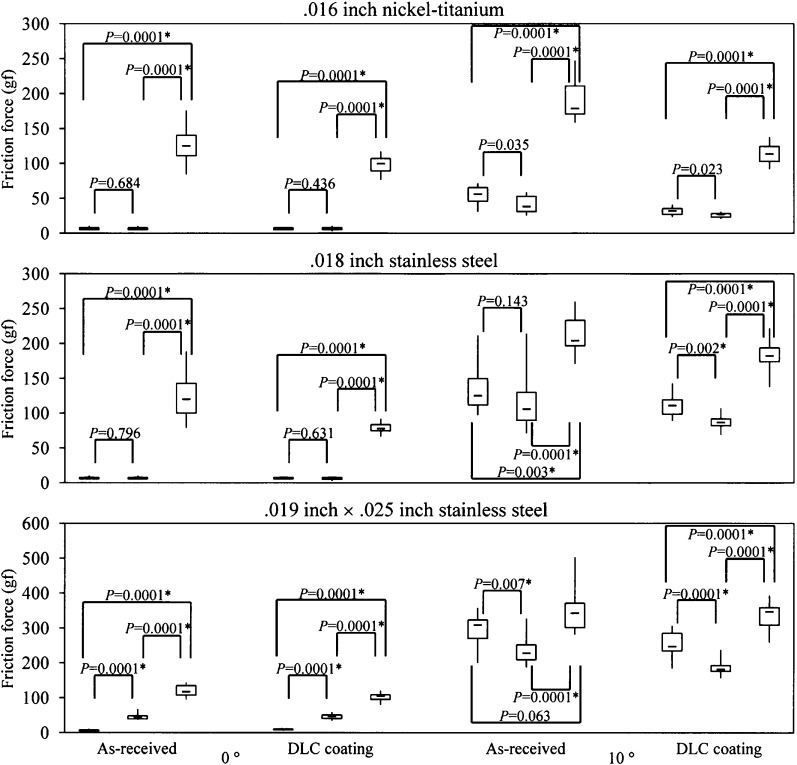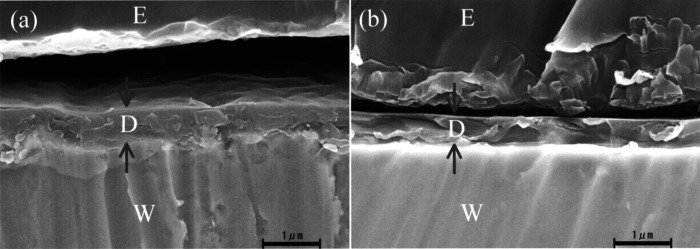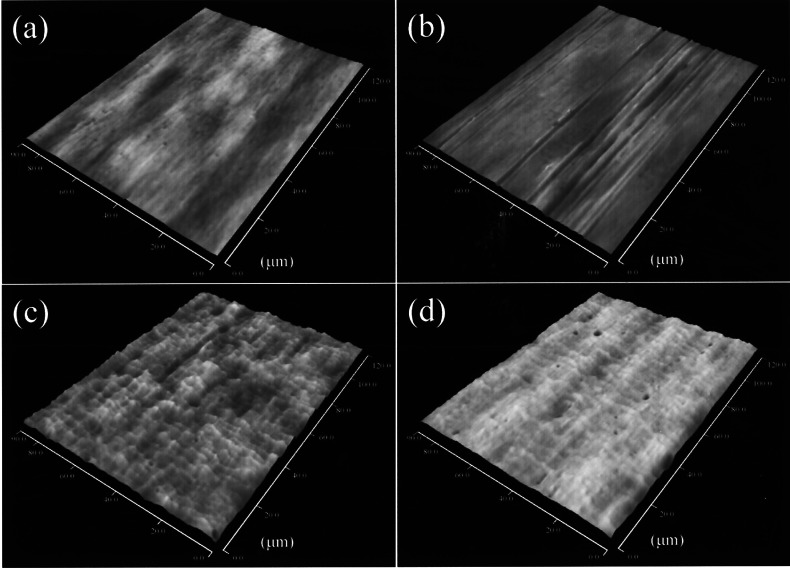Abstract
Objective:
To test the hypothesis that a diamond-like carbon coating does not affect the frictional properties of orthodontic wires.
Materials and Methods:
Two types of wires (nickel-titanium and stainless steel) were used, and diamond-like carbon (DLC) films were deposited on the wires. Three types of brackets, a conventional stainless steel bracket and two self-ligating brackets, were used for measuring static friction. DLC layers were observed by three-dimensional scanning electron microscopy (3D-SEM), and the surface roughness was measured. Hardness and elastic modulus were obtained by nanoindentation testing. Frictional forces and surface roughness were compared by the Kruskal-Wallis and Mann-Whitney U-tests. The hardness and elastic modulus of the wires were compared using Student's t-test.
Results:
When angulation was increased, the DLC-coated wires showed significantly less frictional force than the as-received wires, except for some wire/bracket combinations. Thin DLC layers were observed on the wire surfaces by SEM. As-received and DLC-coated wires had similar surface morphologies, and the DLC-coating process did not affect the surface roughness. The hardness of the surface layer of the DLC-coated wires was much higher than for the as-received wires. The elastic modulus of the surface layer of the DLC-coated stainless steel wire was less than that of the as-received stainless steel wire, whereas similar values were found for the nickel-titanium wires.
Conclusions:
The hypothesis is rejected. A DLC-coating process does reduce the frictional force.
Keywords: Orthodontic wire, Nickel-titanium, Stainless steel, Diamond-like carbon coating, Frictional properties, Nanoindentation test
INTRODUCTION
Friction (resistance to sliding) between the bracket and wire (archwire) during orthodontic tooth movement is an important factor in clinical orthodontics because a decrease in friction might shorten the treatment period and also improve anchorage control.1 There are two types of friction: static and kinetic. Static friction occurs until the force is great enough to overcome the initial resistance to movement of the object; kinetic friction then opposes the continuation of movement.1 The kinetic friction is irrelevant in orthodontic tooth movement because continuous motion along an archwire rarely, if ever, occurs.1 Friction during clinical tooth movement depends on the size and shape of the wire,2 the bracket type,3,4 the bracket and wire materials,5 the angulation of the wire relative to the bracket,6 the type of ligation,2 and whether the environment is wet or dry.7 Kusy and Whitley8 divided friction into three components: (1) friction, static and kinetic, due to contact of the wire with the bracket surface; (2) binding, created when the tooth tips or the wire flexes so that there is contact between the wire and the corners of the bracket; and (3) notching, when permanent deformation of the wire occurs at the wire-bracket corner interface.
Ever since self-ligating brackets were introduced a few decades ago, they have become widely used in clinical orthodontics. A previous study with an in vitro model showed that friction at an angulation of 0° was lower for self-ligating brackets than for a conventional bracket.9 However, when the wire-bracket angulation increased, binding also increased, and the binding was similar with conventional and self-ligating brackets.
Recently, a plasma immersion ion implantation technique has become quite common in surface-coating to improve the mechanical properties and corrosion resistance of beta-titanium10 and nickel-titanium alloys.11 Ion-implanted nickel-titanium wire (Neo Sentally Ionguard, GAC International, Islandia, NY) and beta-titanium wire (Low Friction TMA, Ormco, Orange, Calif) are commercially available. Previous studies12 with an in vitro model have shown that ion-implanted wires (nickel-titanium and beta-titanium) produce less frictional forces during tooth movement, although another randomized clinical trial on initial alignment13 showed that there were no significant differences between ion-implanted nickel-titanium wire and nonimplanted nickel-titanium wire. Another surface-coating technique with diamond-like carbon (DLC), which offers excellent properties such as extreme hardness, low friction coefficients, and high wear-resistance14 is becoming increasingly important in industrial applications, and the application of a DLC film to orthodontic appliances offers the potential of greatly improving frictional properties and corrosion resistance. A recent study showed that DLC films protect against the diffusion of nickel and its release at the surface of nickel-titanium archwires, and that these films are noncytotoxic in a corrosive environment.14 Another research group investigated the effect of DLC coating on the static and kinetic friction of stainless steel, copper nickel-titanium, and beta-titanium wires, and found that DLC coatings of copper nickel-titanium and beta-titanium produced less frictional resistance than found for as-received wires.15 However, they did not study the mechanical properties and morphology of the DLC layer, which greatly influences the frictional properties.
The purpose of this study was to investigate the effect of a DLC coating on the frictional properties of orthodontic nickel-titanium and stainless steel wires. Static friction of the as-received and DLC-coated wires was measured with a custom-fabricated friction-testing device for a conventional bracket and two types of self-ligating brackets. The wire surfaces were characterized by a three-dimensional scanning electron microscope (3D-SEM); the hardness and elastic modulus were investigated by nanoindentation testing. It was hypothesized that a DLC coating does not affect the frictional properties of orthodontic wires.
MATERIALS AND METHODS
Materials
Nickel-titanium wires with a diameter of 0.016 inch (Nitinol Super Elastic, 3M Unitek, Monrovia, Calif) and stainless steel wires with a diameter of 0.018 inch or cross-section dimensions of 0.019 inch × 0.025 inch (stainless steel archwire, 3M Unitek) were used in this study. One hundred twenty upper canine brackets for each of three types were used. The conventional stainless steel brackets (Victory Series, 3M Unitek) had a slot dimension of 0.022 inch, a mesiodistal width of 3.2 mm and no built-in torque or tip. The In-Ovation self-ligating brackets (GAC International) had a slot dimension of 0.022 inch, a mesiodistal width of 3.0 mm and no built-in torque or tip. The Damon Q self-ligating brackets (Ormco, Orange, Calif) had a slot dimension of 0.022 inch, a mesiodistal width of 2.8 mm, 0° torque, and +5° angulation.
DLC-coating Procedure
DLC films were deposited on the nickel-titanium and stainless steel wires using the plasma-based ion implantation/deposition (PBIID) method. All wires were fixed with a custom-made jig in the PBIID equipment (PEKURIS-HI, Kurita Seisakusho, Kyoto, Japan), and deposition was carried out at a target voltage of 5 kV under a pressure of 1.33 × 10−3 Pa and an acetylene gas atmosphere for 400 minutes.16
Friction Test
The static frictional force generated with each wire/bracket combination was measured under dry conditions and at room temperature (25°C) using a custom-fabricated friction-testing device attached to a universal testing machine (EZ Test, Shimadzu, Kyoto, Japan) with a load cell of 20 N (Figure 1a). The custom-fabricated friction-testing device was designed according to the descriptions by Redlich et al.3 and Cha et al.17 Each bracket was bonded with a nonfilled adhesive resin (Superbond, Sun Medical, Shiga, Japan) to a stainless steel plate using a bracket-mounting device (Figure 1b through d), which could give an accurate angulation to the nearest degree. In this study, an angulation of 0° or 10° was selected to position the bracket. The stainless steel plate with the bracket was attached to the friction-testing device, and a 5-cm segment of wire was then ligated to the bracket with an elastomeric ligature (AlastiK Easy-to-Tie Ligatures, 3M Unitek), except that the self-ligating brackets were tested in a closed position. The upper end of the wire was fixed in a grip that was attached to the load cell, and the lower end of the wire was fixed to a 150-g weight. Each wire was drawn through the bracket at a cross-head speed of 10 mm/min for a distance of 5 mm. The static frictional force was determined from load-displacement curves.1 The sample size for each bracket/wire combination and for the two bracket angulations (0° or 10°) was 10. A total of 360 brackets were used in this study.
Figure 1.
Friction-testing system. (a) Custom-fabricated friction-testing device attached to a universal testing machine. (b), (c), and (d) Bracket-mounting device. A, grip; B, bracket/wire combination specimen; C, stainless steel plate; D, weight (150 g); and E, angle measurement device.
3D-SEM Observation and Measurement of the Surface Roughness
To observe the DLC layer in cross-section, representative DLC-coated nickel-titanium and stainless steel wires were encapsulated in epoxy resin (Epofix, Struers, Copenhagen, Denmark) and polished using a series of silicon carbide abrasive papers and a final slurry of 0.05-µm alumina particles; argon ion etching was carried out using an ion shower apparatus (EIS-200ER, Elionix, Tokyo, Japan). The DLC layers were observed by 3D-SEM (ERA-8900, Elionix) with four-channel secondary electron detectors.
To observe and characterize the external surfaces of the as-received and DLC-coated wires, all specimens were sputter-coated with platinum and examined using 3D-SEM. The Ra value, the arithmetic mean of the height of peaks and depth of valleys from a mean line, was used for values of the surface roughness. The Ra at five different areas for each wire was calculated by software that was supplied with 3D-SEM.
Nanoindentation Test
The external surfaces of the as-received and DLC-coated wires were fixed to the specimen stage for the nanoindentation test using adhesive resin. All nanoindentation testing was carried out at 28°C (ENT-1100a, Elionix) using a Berkovich indenter. The measurement points were selected using the optical microscope and charge-coupled device (CCD) camera coupled to the nanoindentation test apparatus. Each test consisted of three segments: 10 seconds for loading to the peak value, a 1-second hold at the peak load, and 10 seconds for unloading. Two peak loads, 5 mN and 100 mN, were used for measurements. The maximum depth of indentation, hardness, and elastic modulus were calculated by software that was supplied with the nanoindentation apparatus, using equations in ISO Standard 14577.18 The sample size for each wire was 10.
Statistical Analysis
Statistical analysis was performed using the Statistical Package for Social Science software (version 16.0J for Windows, SPSS Inc, Chicago, Ill). The data were examined for normality with the Levene's test. Since the data for the mean static frictional force were not normally distributed, values were compared using the Kruskal-Wallis test and the Mann-Whitney U-test. Significance was predetermined at P < .0167. Since the data for surface roughness were also not normally distributed, mean values were compared by the Mann-Whitney U-test (P < .05). Since the data were normally distributed for the maximum depth of indentation, hardness, and elastic modulus, mean values for the as-received and DLC-coated wires were compared using Student's t-test (P < .05).
RESULTS
Table 1 and Figure 2 show static frictional forces for angulations of 0° and 10° for conventional and self-ligating brackets and for as-received and DLC-coated wires. When the angulation was increased to 10°, the frictional forces increased in all of the bracket-wire combinations, and the DLC-coated nickel-titanium and stainless steel wires showed significantly less frictional force than as-received wires, except for some wire/bracket combinations. Both self-ligating brackets showed significantly less frictional force than the conventional bracket at 0° angulation. When angulation was increased to 10°, both self-ligating brackets had significantly less frictional force than the conventional bracket for the as-received wires, except for the Damon Q bracket/as-received 0.019 inch × 0.025 inch stainless steel wire combination (P = .063).
Table 1.
Static Frictional Forces for 0° and 10° Angulations of Conventional (Victory) and Self-Ligating Brackets (Damon Q, In-Ovation) to As-Received and DLC-Coated Wiresa
Figure 2.
Static frictional forces for angulations of 0° and 10° for conventional and self-ligating brackets with as-received and DLC-coated wires. Comparisons are presented for each bracket in the three types of wires. Left side, Damon Q; middle, In-Ovation; and right side, Victory brackets. * P < .0167 by Mann-Whitney U-test; ns indicates nonsignificant.
Figure 3 shows representative SEM photomicrographs for cross-sectioned DLC-coated stainless steel and nickel-titanium wires. The figure clearly shows that the thin DLC layers on the wire surfaces have a thickness of approximately 0.5 µm.
Figure 3.
SEM photomicrographs of cross-sectioned (a) stainless steel and (b) nickel-titanium wires. DLC layers formed on the wires are evident. Original magnification 20,000×. E indicates epoxy resin; D, DLC layer; and W, wire.
Figure 4 shows 3D-SEM images of stainless steel and nickel-titanium wires. The as-received and DLC-coated wires had similar surface morphologies for both the stainless steel and nickel-titanium wires. On the other hand, the surface morphology of the nickel-titanium wires was rougher than that of the stainless steel wires. Quantitative analysis of the surface roughness shown in Table 2 confirmed that the nickel-titanium wires had greater surface roughness than the stainless steel wires, and the DLC-coating process did not affect the surface roughness (P = .548).
Figure 4.
Images of stainless steel and nickel-titanium wires obtained with four-channel 3D-SEM. (a) As-received stainless steel wire. (b) DLC-coated stainless steel wire. (c) As-received nickel-titanium wire. (d) DLC-coated nickel-titanium wire. Original magnification 1000×.
Table 2.
Average Surface Roughness (Ra Value) for Stainless Steel and Nickel-Titanium Wires
The mean values and standard deviations for the maximum depth of indentation hmax, hardness, and elastic modulus obtained in the nanoindentation tests on the wire surfaces (5 and 100 mN peak load) are listed in Table 3. The mechanical properties obtained with a 5 mN peak load are mainly for the DLC layers because the hmax of the 5 mN peak load was less than 300 nm for both stainless steel and nickel-titanium wires. The hardness for the DLC-coated stainless steel and nickel-titanium wires obtained with the 5 mN load was much higher than that of the as-received stainless steel (P = .0001) and nickel-titanium wires (P = .0001). On the other hand, the elastic modulus for the DLC-coated stainless steel wire obtained with a 5 mN load was less than that of the as-received stainless steel wire (P = .0001). The hardness and elastic modulus for nickel-titanium wires obtained with a 100 mN load were similar for DLC-coated and as-received wires.
Table 3.
Summary of Mechanical Properties for As-Received and DLC-Coated Wires Obtained by the Nanoindentation Test
DISCUSSION
Frictional force between the bracket and the wire during orthodontic tooth movement is an important factor in clinical orthodontics, and if the frictional force can be decreased, the efficiency of tooth movement can be improved. The frictional forces increased when the angulation was increased for all of the bracket-wire combinations in this study, and this is consistent with previous studies.3,17 In this study, although the stainless steel wire showed smoother and harder surface characteristics than the nickel-titanium wire, the stainless steel wires had greater frictional forces than the nickel-titanium wires. The stainless steel wires had wider cross-section dimensions and a higher value of the elastic modulus than the nickel-titanium wires, and this should have affected binding and notching.
DLC coatings are becoming increasingly important in industrial and biomedical applications.19,20 Hardness is often the most noted property of DLC coatings. It can be challenging to determine the true mechanical properties of a material that exists only as a thin coating less than a few micrometers thick. The recent development of the nanoindentation technique, which offers nanometer-scale resolution, has allowed such measurements to be successfully performed.21 Most DLC films are harder than most metallic materials, and DLC coating by the PBIID gives hardness values ranging from 6 GPa to 20 GPa depending on the deposition conditions.19,20 In this study, the hardness values of the DLC layer on the stainless steel (17.6 GPa) and nickel-titanium wires (9.1 GPa) were determined by the nanoindentation test and were significantly higher than the hardness values of the surface layers on the as-received stainless steel (11.6 GPa) and nickel-titanium wires (4.7 GPa). This study clearly demonstrated that the DLC-coating process reduces frictional force. The harder surface of the DLC-coated wires not only reduces friction but also reduces the effects of binding and notching. In addition, the DLC layer on the stainless steel and nickel-titanium wires showed a lower elastic modulus than the surface layer on the as-received wires. DLC-coated wires with a lower elastic modulus might show superior flexibility, which is a desirable characteristic of an orthodontic wire. Further research is needed to evaluate the flexibility of the DLC-coated orthodontic wires.
The basic advantages of self-ligating brackets involve the elimination of certain utilities or materials such as elastomeric modules, along with the process or tools associated with their application.4 In addition, it has been proposed that due to bracket-wire engagement, light forces and reduced friction can be attained with a desirable outcome on the rate of orthodontic tooth movement.22 However, a recent study concluded that a self-ligating bracket was no better during initial alignment than a conventional bracket.4 In the present study, both self-ligating brackets produced significantly less frictional forces in both angulations (0° or 10°) than the conventional bracket. The self-ligating brackets produced almost 0 g for 0° angulation, excluding the In-Ovation bracket/0.019 inch × 0.025 inch stainless steel wire combination. However, this condition (0° angulation) never occurs clinically. When angulation was increased to 10°, the In-Ovation bracket showed a lower rate of increase in the frictional force than the Damon Q bracket, even though the In-Ovation bracket has a wider mesiodistal width than the Damon Q bracket. The results of this study showed that a self-ligating bracket/DLC-coated wire combination is beneficial for orthodontic tooth movement.
CONCLUSIONS
The surfaces of nickel-titanium and stainless steel orthodontic wires can be successfully modified by the PBIID method to create a DLC layer.
The DLC-coating process reduces the frictional force for these wires in brackets.
The DLC layer has a higher hardness value than the as-received wires.
Self-ligating brackets produce less frictional force than the conventional stainless steel bracket.
Acknowledgments
The authors thank Masahiko Sugihara and Yoshimi Nishimura at Kurita Seisakusho for their expert technical assistance with the DLC-coating procedure, and Yukiko Omata and Yoichiro Morita at Elionix for kindly performing the SEM observations.
REFERENCES
- 1.Burrow S. J. Friction and resistance to sliding in orthodontics: a critical review. Am J Orthod Dentofacial Orthop. 2009;135:442–447. doi: 10.1016/j.ajodo.2008.09.023. [DOI] [PubMed] [Google Scholar]
- 2.Bazakidou E, Nanda R. S, Duncanson M. G, Jr, Sinha P. Evaluation of frictional resistance in esthetic brackets. Am J Orthod Dentofacial Orthop. 1997;112:138–144. doi: 10.1016/s0889-5406(97)70238-5. [DOI] [PubMed] [Google Scholar]
- 3.Redlich M, Mayer Y, Harari D, Lewinstein I. In vitro study of frictional force during sliding mechanics of “reduced-friction” brackets. Am J Orthod Dentofacial Orthop. 2003;124:69–73. doi: 10.1016/s0889-5406(03)00238-5. [DOI] [PubMed] [Google Scholar]
- 4.Miles P. G, Weyant R. J, Rustveld L. A clinical trial of Damon 2 vs conventional twin brackets during initial alignment. Angle Orthod. 2006;76:480–485. doi: 10.1043/0003-3219(2006)076[0480:ACTODV]2.0.CO;2. [DOI] [PubMed] [Google Scholar]
- 5.Saunders C. R, Kusy R. P. Surface topography and frictional characteristics of ceramic brackets. Am J Orthod Dentofacial Orthop. 1994;106:76–87. doi: 10.1016/S0889-5406(94)70024-9. [DOI] [PubMed] [Google Scholar]
- 6.Frank C. A, Nikolai R. J. A comparative study of frictional resistance between orthodontic bracket and archwire. Am J Orthod Dentofacial Orthop. 1980;78:593–609. doi: 10.1016/0002-9416(80)90199-2. [DOI] [PubMed] [Google Scholar]
- 7.Thorstenson G, Kusy R. Influence of stainless steel inserts on the resistance to sliding of esthetic brackets with second-order angulation in the dry and wet states. Angle Orthod. 2003;73:167–175. doi: 10.1043/0003-3219(2003)73<167:IOSSIO>2.0.CO;2. [DOI] [PubMed] [Google Scholar]
- 8.Kusy R. P, Whitley J. Q. Influence of archwire and bracket dimensions on sliding mechanics: derivations and determinations of the critical contact angles for binding. Eur J Orthod. 1999;21:199–208. doi: 10.1093/ejo/21.2.199. [DOI] [PubMed] [Google Scholar]
- 9.Thorstenson G, Kusy R. Comparison of resistance to sliding between difference self-ligating brackets with second-order angulation in the dry and saliva state. Am J Orthod Dentofacial Orthop. 2002;121:472–482. doi: 10.1067/mod.2002.121562. [DOI] [PubMed] [Google Scholar]
- 10.Kusy R. P, Tobin E. J, Whitley J. Q, Sioshansi P. Frictional coefficients of ion-implanted alumina against ion-implanted beta-titanium in the low load, low velocity, single pass regime. Dent Mater. 1992;8:167–172. doi: 10.1016/0109-5641(92)90076-o. [DOI] [PubMed] [Google Scholar]
- 11.Yeung K. W, Poon R. W, Liu X. Y, et al. Corrosion resistance, surface mechanical properties, and cytocompatibility of plasma immersion ion implantation-treated nickel-titanium shape memory alloys. J Biomed Mater Res A. 2005;75:256–267. doi: 10.1002/jbm.a.30413. [DOI] [PubMed] [Google Scholar]
- 12.Wichelhaus A, Geserick M, Hibst R, Sander F. G. The effect of surface treatment and clinical use on friction in NiTi orthodontic wires. Dent Mater. 2005;21:938–945. doi: 10.1016/j.dental.2004.11.011. [DOI] [PubMed] [Google Scholar]
- 13.Cobb N. W, Kula K. S, Phillips C, Proffit W. R. Efficiency of multi-strand steel, superelastic Ni-Ti and ion-implanted Ni-Ti archwires for initial alignment. Clin Orthod Res. 1998;1:12–19. doi: 10.1111/ocr.1998.1.1.12. [DOI] [PubMed] [Google Scholar]
- 14.Kobayashi S, Ohgoe Y, Ozeki K, Hirakuri K, Aoki H. Dissolution effect and cytotoxicity of diamond-like-carbon coating on orthodontic archwires. J Mater Sci Mater Med. 2007;18:2263–2268. doi: 10.1007/s10856-007-3118-2. [DOI] [PubMed] [Google Scholar]
- 15.Bentahar Z, Barouins M, Clin M, Bouhammar N, Boussiri K. Tribological performance of DLC-coated stainless steel, TMA and Cu-NiTi. Int Orthod. 2008;6:335–342. [Google Scholar]
- 16.Aisenberg S, Chabot R. Ion-beam deposition of thin films of diamondlike carbon. J Appl Phys. 1971;42:2953–2958. [Google Scholar]
- 17.Cha J, Kim K, Hwang C. Friction of conventional and silica-insert ceramic bracket in various bracket-wire combinations. Angle Orthod. 2007;77:100–107. doi: 10.2319/092705-333R.1. [DOI] [PubMed] [Google Scholar]
- 18.ISO 14577-1 Metallic materials – Instrumented indentation test for hardness and materials parameters Part 1 Test method 1st ed. 2002. International Organization for Standardization;
- 19.Sridharan K, Anders S, Nastasi M, Walter K. C, Anders A, Monterio O. R, Ensinger W. Nonsemiconductor application of PIII&D. In: Anders A, editor. Handbook of Plasma Immersion Ion Implantation and Deposition. New York, NY: Wiley & Sons; 2000. [Google Scholar]
- 20.Fontaine J, Donnet C, Erdemir A. Fundamentals of the tribology of DLC coating. In: Donnet C, Erdemir A, editors. Tribology of Diamondlike Carbon Films. New York, NY: Springer; 2008. pp. 139–154. [Google Scholar]
- 21.Alcock J. P, Barbour M. E, Sandy J. R, Ireland A. J. Nanoindentation of orthodontic archwires: the effect of decontamination and clinical use on hardness, elastic modulus and surface roughness. Dent Mater. 2009;25:1039–1043. doi: 10.1016/j.dental.2009.03.003. [DOI] [PubMed] [Google Scholar]
- 22.Pandis N, Eliades T, Bourauel C. Biomechanics of self-ligation: analysis of forces and moments exerted by self-ligation brackets. In: Eliades T, Pandis N, editors. Selfligation in Orthodontics. West Sussex, UK: Wiley-Blackwell; 2009. pp. 33–44. [Google Scholar]



